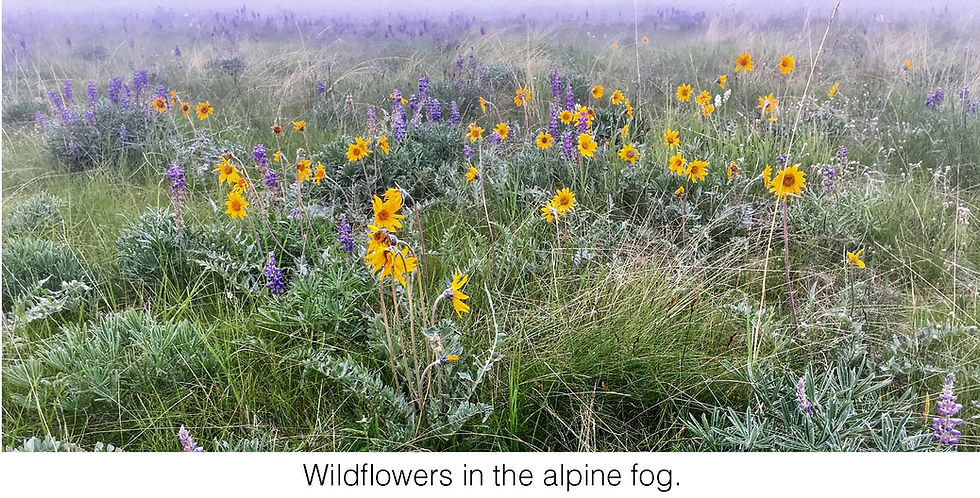MY LIFE WITH PLANTS: Wyoming's Wonderful Wildflowers
- Rachel Cobb
- Oct 1, 2018
- 3 min read
Updated: Jul 25, 2022

By Jim Bishop.
In July, Scott and I visited western South Dakota and Wyoming. We were in search of alpine wildflowers in the mountains to the east of Yellowstone National Park. We were not disappointed.
Panayoti Kelaidis had recommended the trip on several locations. You may recall that Panayoti, senior curator and director of outreach at Denver Botanic Gardens, was the SDHS speaker in February of 2017. On his recommendation, we stayed at accommodations just outside of Cody, Wyoming. The site is high above the town with a wonderful view of the surrounding mountains. It also has its own cultivated garden, as well as a large hill behind the property covered with native plants.
Our first major encounter with alpine wildflowers was while driving the Cloud Peak Skyway Scenic Byway through the Bighorn National Forest on our way to Cody. As we got closer to byway's peak at the 9,666-foot Powder River Pass, we drove into dense fog and found out why the byway is named Cloud Peak. We were definitely in the clouds. After several miles of slow and blind driving, we decided to pull over for a bit and see if there were any flowers. Just a few feet from the road, we were in the middle of an alpine wildflower meadow. It was loaded with mule's ears (Wyethia mollis), lupine, and countless other wildflowers and bunch grasses all dripping with condensation from the fog.
As we came over the crest at Powder River Pass, the fog lifted to reveal that the large plants had given way to tundra. It too was loaded with wildflowers, but all in miniature as they were at most several inches tall. We saw forget-me-nots, Sedum, Phlox, lichen, mosses, and countless others.


The next day, we set out to the mountain passes a bit further north. The highway there follows Shell Canyon. The lower walls of the canyon are limestone that was laid down over 500 million years ago. Towards the top of the road, there are some scenic waterfalls that cut through the colorful limestone. Being a bit drier landscape, there are fewer wildflowers, but still plenty to see, including sego lilies, buckwheat, pink paintbrush, and Gaura. Higher up, we stopped for lunch at the deserted Cabin Creek Picnic Ground and again found ourselves immersed in wildflower meadows set against a backdrop of white and black aspen trunks and surrounded by evergreen mountains. Here we found new species we hadn’t seen at other locations, including Iris missouriensis, geraniums, Geum triflorum (prairie smoke), delphiniums, and a sea of dandelion seed heads. But most spectacular was Frasera speciosa (elkweed), each flower having a pale green calyx with four brown-spotted sepals borne on a tall inflorescence rising from a whorl of basil-pointed leaves. They hardly seemed real.
We continued upward to Medicine Wheel, a native spiritual destination. It was in the parking lot there that we found the pale lavender pasque flower in bloom. We had seen the seed heads previously at the Cloud Peak Skyway covered in fog drip, but not the flowers. There was still some snow left in spots here, and again many varieties of wildflowers we hadn’t encountered at previous stops.
The next day, we set out again for a scenic drive through the mountains and towards the northeast entrance of Yellowstone National Park. The Beartooth Highway starts just before entering Montana and was still blocked from snow, but we were able to enjoy some wonderful alpine lakes surrounded by melting snow and many fast-running streams. On the way down, we stopped to look at the view and watched a thunderstorm roll out of the distant mountains and eventually over us. We also heard the cry of a lone wolf at one of our stops. Again, there were different species of wildflowers, including yellow violas and golden orange and yellow snowdrops. We took a quick trip into Yelllowstone and encountered a moose at our first stop.

On our final day, we did a short drive towards the eastern entrance to Yellowstone along the Shoshone River. Above the river are red and yellow limestone spires and hoodoos that look like something you would more likely expect in the desert southwest than in Wyoming. We only had time for one stop at the river’s edge, but there were still plenty of wildflowers to check out.
